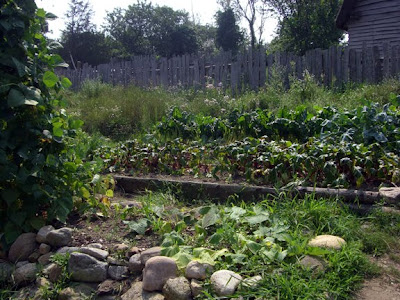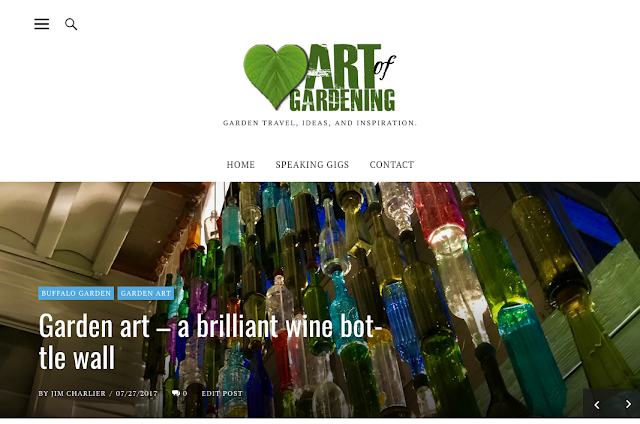A Pilgrim's garden

NOTE: This is a repost from 2011...
Back in August, we visited Plimouth Plantation, a recreated village representing how the Pilgrims lived when they first came over on the Mayflower. I posted a while back about the gardens of the local Wampanoag Nation. Here's the Pilgrim garden post.
 The deeply religious Pilgrims did not show skin and thought of the Wampanoags as ignorant and child-like in their skin-exposing clothing. Can you imagine gardening in the hot sun dressed like this?
The deeply religious Pilgrims did not show skin and thought of the Wampanoags as ignorant and child-like in their skin-exposing clothing. Can you imagine gardening in the hot sun dressed like this?Men planted fields of wheat, barley, peas -- all from seeds brought over from Europe. They also planted new plants the Wampanoags introduced to them -- corn, beans squash and pumpkins. Fields were outside the village and where men would go and spend their days. The Wampanoags also helped show the pilgrims when to plant and how to plant seeds in poor soil by burying seeds with fish to decompose & nourish the soil.
 Raised-bed gardens allowed them to condition their soils appropriate to the plantings within.Produce not only fed themselves, but was traded with the Wampanoags for furs. Most furs were shipped back to Europe to sell, so they'd have money to purchase clothing, sugar, spices, gunpowder and more. So life & economy depended on their gardens. Indian corn was different from what we eat today -- it had different colors on the same ear, and was not eaten off the cob. It was dried and pounded into flour for cooking & baking. Corn was part of almost every meal.
Raised-bed gardens allowed them to condition their soils appropriate to the plantings within.Produce not only fed themselves, but was traded with the Wampanoags for furs. Most furs were shipped back to Europe to sell, so they'd have money to purchase clothing, sugar, spices, gunpowder and more. So life & economy depended on their gardens. Indian corn was different from what we eat today -- it had different colors on the same ear, and was not eaten off the cob. It was dried and pounded into flour for cooking & baking. Corn was part of almost every meal. The village was made of a couple dozen homes. Back then, people had little education and tended to spell things phonetically (like my sixth-grader). In much official correspondence the settlement was referred to as "Plimouth" not today's "Plymouth." So when deciding the name of this unique tourist attraction, they settled on what the settlers used -- "Plimouth Plantation."
The village was made of a couple dozen homes. Back then, people had little education and tended to spell things phonetically (like my sixth-grader). In much official correspondence the settlement was referred to as "Plimouth" not today's "Plymouth." So when deciding the name of this unique tourist attraction, they settled on what the settlers used -- "Plimouth Plantation."Each home had its own garden as well, for each family's consumption. Women grew basil, parsley, lettuce, carrots, turnips and onions. It was the kid's job to weed. In most cases, the folks coming over on the Mayflower had never gardened before. Now they had to garden to live through the winters. If I had to live off the produce from my garden, I wouldn't last though September.
 Plymouth Rock is worth a quick look, but really, it's just a rock. The actors that populate Plimouth Plantation stay not only in character, they take on the persona of an actual person that came over on the Mayflower. We ran across a Pilgrim woman in her back yard sitting in the shade near her garden. People were asking her all sorts of questions about her garden. She was Dutch, as many of the Pilgrims were. many of the Pilgrims had left England a decade or so earlier to settle in Amsterdam, married there and brought their families to New England with them.
Plymouth Rock is worth a quick look, but really, it's just a rock. The actors that populate Plimouth Plantation stay not only in character, they take on the persona of an actual person that came over on the Mayflower. We ran across a Pilgrim woman in her back yard sitting in the shade near her garden. People were asking her all sorts of questions about her garden. She was Dutch, as many of the Pilgrims were. many of the Pilgrims had left England a decade or so earlier to settle in Amsterdam, married there and brought their families to New England with them. Some kid's got some weeding to do.One person asked if they grew tomatoes. She didn't know what a tomato was. She asked if they knew the name of tomato in Dutch, then she might be able to help. So of course, some wise-ass pulls out his iPhone and was looking up the Dutch word for tomato. Back in the 1600s, tomatoes were not a known commodity.
Some kid's got some weeding to do.One person asked if they grew tomatoes. She didn't know what a tomato was. She asked if they knew the name of tomato in Dutch, then she might be able to help. So of course, some wise-ass pulls out his iPhone and was looking up the Dutch word for tomato. Back in the 1600s, tomatoes were not a known commodity. We also went into the town of Plymouth to see the Mayflower reproduction ship. There were more actors on board answering questions about their voyage over. The trip over sucked -- spending most of their time below deck and sharing meager rations with rats. Though on the plus side, all they drank was beer. That's what everyone drank all the time. It was a very weak beer and safe to drink, as opposed to the available water.
We also went into the town of Plymouth to see the Mayflower reproduction ship. There were more actors on board answering questions about their voyage over. The trip over sucked -- spending most of their time below deck and sharing meager rations with rats. Though on the plus side, all they drank was beer. That's what everyone drank all the time. It was a very weak beer and safe to drink, as opposed to the available water.Make sure you get some classic Pilgrim foods – corn & beer! Happy Thanksgiving to you all.






Great post. I love your comment about the wise-ass. I've seen advertisments, maybe you seen them, for these cell phones [?] that will answer any question on Google [I think.] So the parent hands it to the kid because he's asking THEM too many questions. ... Last I heard answering your kids' questions was part of being a parent, but whatever. Anyway, the Pilgrim life was so horrendously hard. I am such a wuss. Just thinking about how they lived depresses me. I've so much to be thankful for. Thanks for the reminder.
ReplyDeleteYou're right, those kids need to do some weeding! :-) I can hardly imagine the kind of life they must have had. Interesting to hear how most had never gardened before. That's probably the hardest thing to imagine - learning to garden because my life depends on it! Thanks for the interesting lesson. I'm thankful to live when I do (despite the cell phones).
ReplyDeleteThere was no standard spelling until Webster published his dictionary over a century after the Pilgrims landed in Plymouth. It is not that they were uneducated, standard spelling had not be invented.
ReplyDelete